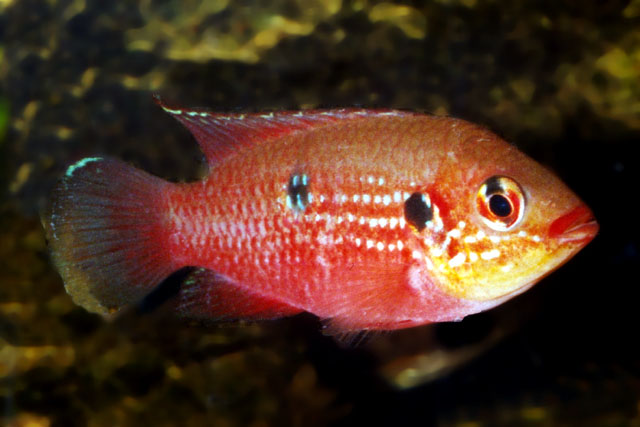| Cichlidae (Cichlids), subfamily: Pseudocrenilabrinae |
| 10 cm SL (male/unsexed) |
|
benthopelagic; freshwater, |
| Africa: Equatorial Guinea to Cabinda, including central regions of Gabon (Ref. 81260). Also in western Republic of Congo (Ref. 81260) and in the Congo River from Pool Malebo (=Stanley Pool) to its estuary (Ref. 43352). Also present in the Likouala and Likouala-aux-Herbes, upstream from Pool Malebo in the middle Congo River basin, in Republic of Congo (Ref. 43352). |
|
Dorsal spines (total): 13-15; Dorsal soft rays (total): 10-12; Anal spines: 3-3; Anal soft rays: 7-9. Diagnosis: never with multiple series of distinct blotches or bars on flanks; iridophores often visible on head, but rarely present on body or unpaired fins; mid-lateral black spot always present, rounded and relatively large, sometimes bordered by a light zone around posterior and anterior edges (but not fully ocellated); sometimes small black spots and/or 7-9 narrow black bars on dorsum, sometimes reaching to mid-body; black spot on caudal peduncle normally absent, or if present, small and ovoid (Ref. 81260).
Description: relatively robust, deep-bodied (body depth 36.0-44.8% SL); head length 35.4-38.5% SL (Ref. 81260). Snout short (Ref. 81260), pointed (Ref. 52307). Frontal profile slightly concave; large males sometimes develop a small hump on head; caudal fin rounded (Ref. 52307). Mouth small; lower jaw only slightly prognathous; lower lip fold just overlaps upper lip at corner of mouth; single row of small, evenly spaced unicuspid teeth in upper jaw, occasionally a few inner row teeth at symphysis; caudal peduncle always deeper than long; first pelvic ray longest in both sexes; some dorsal and anal fin rays elongated; caudal fin rounded in both sexes; chest scales smaller than body scales (Ref. 81260).
Coloration: sexually inactive specimens: reddish brown to yellow, darker dorsally than chest and belly; lips, lower cheeks and opercle yellow; ventrum with a rosy flush; 1 relatively large, mid-lateral black spot, sometimes bordered with yellow on the posterior and anterior edges, but never fully encircled and ocellated; occasionally with a small, ovoid spot at base of caudal peduncle; bright blue iridophores on snout, cheek, opercle, and rarely also on outer edges of dorsal and caudal fins; body scales without blue iridophores but often (always in populations from Gabon) with blue margins around each scale; unpaired fins and pelvic fins yellowish to rosy; dorsal and upper part of caudal fin with thin red margin and thin blue submargins; anterior leading edge of pelvic fins red to violet; sometimes several black spots and/or 7-9 thin black bars descending down over flanks (Ref. 81260). Sexually active specimens (from the Congo): dorsum, unpaired fins and pelvic fins yellow to brownish-orange, the last with a red to violet anterior leading edge; dorsal and upper part of caudal fins with thin red margin and thin blue submargin; cheek and lower part of opercle yellow; venter bright red to violet (Ref. 81260). Sexually active specimens (from Gabon): head and body bright red, with a greenish to yellowish flush on dorsum; body scales often with blue margins; unpaired and pelvic fins red; dorsal and upper part of caudal fin with blue submargin; blue iridophores on head visible as in non-sexually active specimens (Ref. 81260). Juveniles < 12mm brownish with a prominent black mid-lateral band (Ref. 81260). |
| Pair-bonding, substrate brooder (Ref. 52307, 81260). |
|
Least Concern (LC); Date assessed: 16 February 2009 Ref. (130435)
|
| harmless |
Source and more info: www.fishbase.org. For personal, classroom, and other internal use only. Not for publication.

